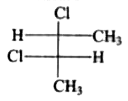If the optical rotation produced by the compound (A) is +52∘, the one produced by compound (B) is :

A
−52∘
B
+52∘
C
0∘
D
Unpredictable
Video Solution
Text Solution
The correct Answer is:A
Since (A) and (B) are enantiomers, so specific rotation of B is −52∘ (because enantiomers have equal and opposite specific rotation).
|
Topper's Solved these Questions
- ISOMERISMBOOK - CENGAGE CHEMISTRY ENGLISHCHAPTER - ISOMERISMEXERCISE - Single correct answer type (Exercise)
65 Videos
- ISOMERISMBOOK - CENGAGE CHEMISTRY ENGLISHCHAPTER - ISOMERISMEXERCISE - Assertion-Reasoning Type (Exercise)
5 Videos
- ISOMERISMBOOK - CENGAGE CHEMISTRY ENGLISHCHAPTER - ISOMERISMEXERCISE - Multiple choice questions (Exercise)
38 Videos
- IONIC EQUILIBRIUMBOOK - CENGAGE CHEMISTRY ENGLISHCHAPTER - IONIC EQUILIBRIUMEXERCISE - Archives Subjective
28 Videos
- NCERT BASED EXERCISEBOOK - CENGAGE CHEMISTRY ENGLISHCHAPTER - NCERT BASED EXERCISEEXERCISE - Chemical Equilibrium
73 Videos
Similar Questions
Knowledge Check
An optically active compound
Arotates the plane of polarised lightBchanges the direction of polarised lightCdoes not allow plane polarised light to pass throughDnone of these.Among the following, the optically inactive compound is :
A B
B C
C D
D
Grignard reagents produce carbonyl compounds with
ACO2BR−C≡NCR−O∣∣C−ClDR−O∣∣C−O−R'
The optical rotation of an optically active compound is +20∘. The length of tube is 10cm and the density of solution is 0.4gmml−. The specific rotation of the compound is:
i. +50∘ ii. +500∘ iii. +5∘ iv. +0.5∘
View SolutionThe optically inactive compound from the following is :-
View SolutionIdentify the compound that on hydrogenation produces an optically active compound from the following compounds :

View SolutionAmong the following, the optically inactive compound is
View SolutionIdentify the optically active compounds from the following
View Solution


 is :
is :